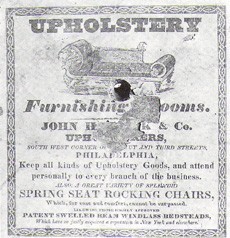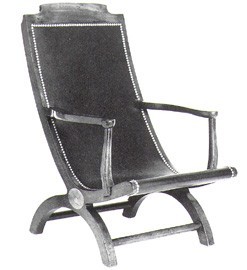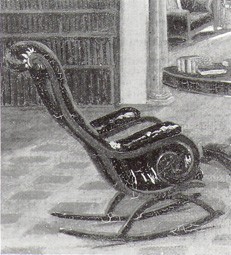
View of Walnut Street Between Third and Fourth Streets, Philadelphia, 1830—1840. Watercolor on paper. 18 3/4" x 33 1/2". (Courtesy, Library Company of Philadelphia.) Hancock's rented four-story brick wareroom is shown on the left corner. An insurance survey indicated that building was 31' x 43' and that the middle two floors were partitioned into two rooms. The building was centrally located in Philadelphia's commerical district, directly opposite the merchants' Exchange and close to the waterfront.

Rocking chair, labeled "John Hancock & Co.," Philadelphia, 1831—1840. Maple, mahogany, and pine H. 41", W. 24", D. 27". (Courtesy, Winterthur Museum, acc. 90.82.) A roll of curled hair forms a headrest, a thin padding of hair sandwiched between two pieces of fabric and twined to the spindles forms the back upholstery, and two pieces of fabric padded with hair form the arm panels. The replaced burlap cover of the left arm has been removed, revealing the curled hair and tow stuffing. The perimeter of the finish cover had a matching gimp and closely spaced brass nails.

Label on the underside of the rocking chair seat illustrated in fig. 2. (Photo, Winterthur Museum.) The firm remained at Walnut and Third streets until 1840.

Campeche chair, Philadelphia, 1810—1820. Mahogany, satinwood inlay. H. 37 1/2", W. 23 7/8", D. 30 1/2". (Private collection; photo, Winterthur Museum.) The original owner of this chair was Franklin Bache (1797—1864), Benjamin Franklin's great grandson.

George Bacon Wood, Jr., Interior of the Library of Henry C. Carey, Philadelphia, 1879. 14" x 20 1/4". (Courtesy, Pennsylvania Academy of the Fine Arts, Philadelphia. Gift of the artist.)

Detail of the Spanish rocking chair in the left foreground of the painting in fig. 5. The chair appears to have been upholstered in green plush. (Courtesy, Pennsylvania Academy of the Fine Arts, Philadelphia. Gift of the artist.)

Detail of the Spanish armchair in the right foreground of the painting in fig. 5. The chair also appears to have been upholstered in green plush. (Courtesy, Pennsylvania Academy of the Fine Arts, Philadelphia. Gift of the artist.)
